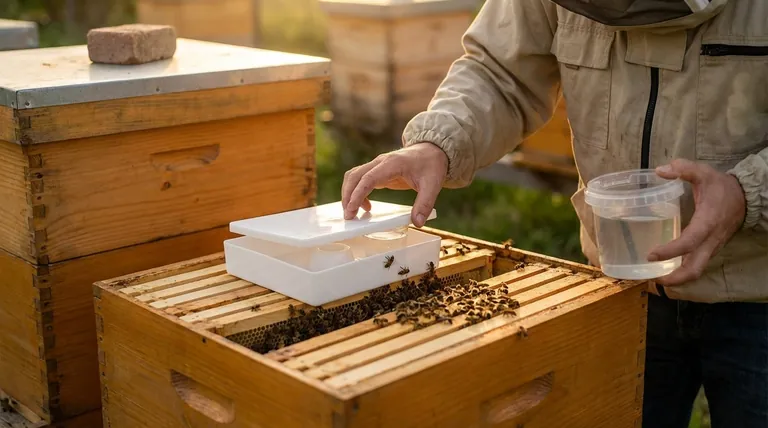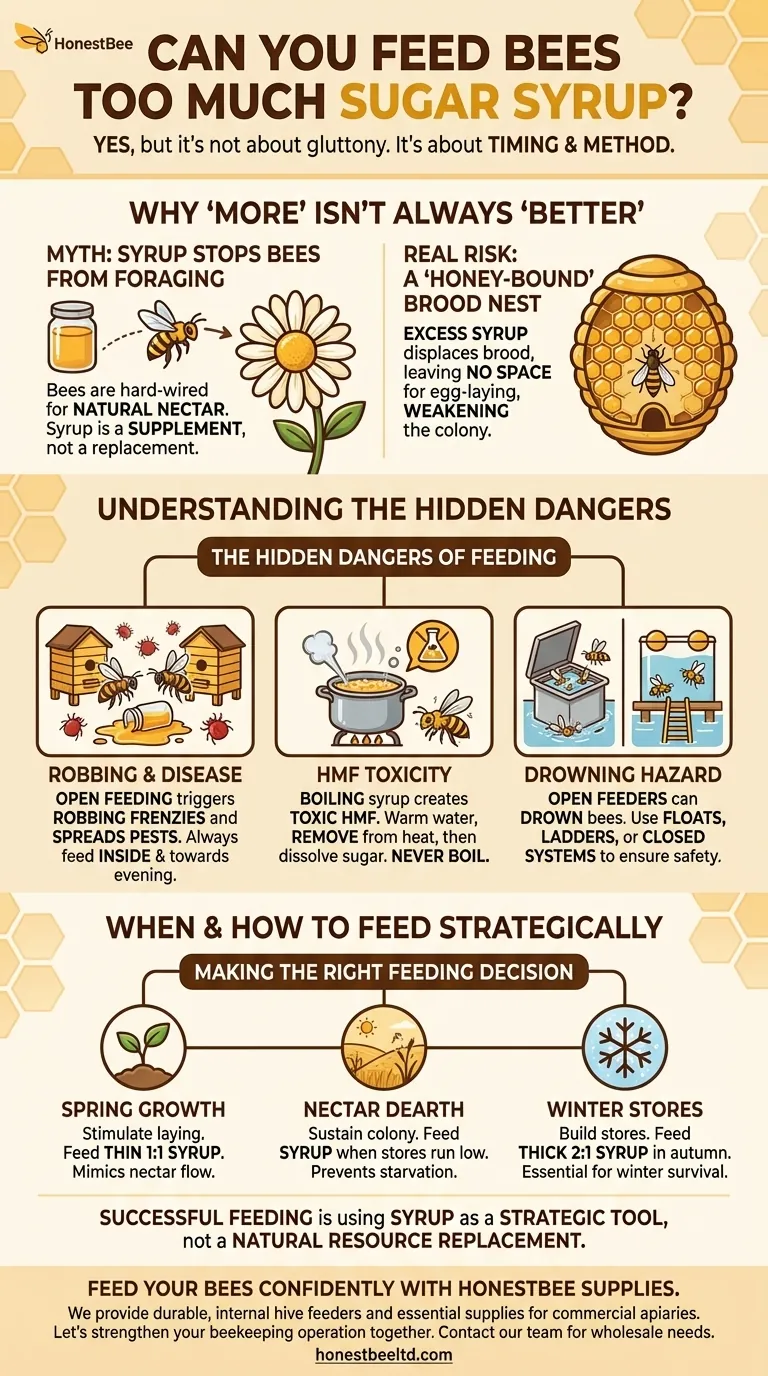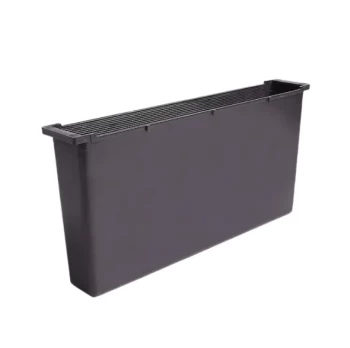Yes, you can feed bees too much sugar syrup, but not in the way you might think. The primary danger is not that individual bees will overeat, but that an excess of syrup in the hive at the wrong time can disrupt the colony's natural cycle, displace essential honey stores, and create dangerous secondary problems like hive robbing and disease transmission.
The core issue isn't the quantity of syrup itself, but the timing and method of feeding. Improper feeding can lead to a "honey-bound" brood nest, attract robbers from other colonies, and even introduce toxins if the syrup is prepared incorrectly.

Why "More" Isn't Always "Better"
The most common concern—that feeding will make bees lazy—is largely a myth. However, providing too much syrup introduces other, more significant risks to the colony's health and productivity.
Myth: Syrup Stops Bees from Foraging
Honey bees are hard-wired to seek out natural nectar. They will almost always prefer foraging for nectar over consuming sugar syrup if a natural source is available.
Syrup is a supplement, not a replacement. It serves to bridge the gap when nectar is scarce, ensuring the colony has the energy it needs to survive and grow.
The Real Risk: A "Honey-Bound" Brood Nest
The most direct negative consequence of overfeeding is creating a "honey-bound" hive. This happens when bees store so much syrup in the brood chamber that there is no empty space left for the queen to lay eggs.
A lack of egg-laying space can severely shrink the colony's population over time, weakening it significantly and jeopardizing its long-term survival. This is especially damaging during the spring and summer buildup periods.
Understanding the Hidden Dangers of Feeding
Beyond disrupting the brood nest, the way you feed can present immediate dangers to your bees and others in the area.
The Threat of Robbing and Disease
Sugar syrup is highly attractive to bees from other colonies, both managed and feral. Any spilled syrup or open feeding can trigger a "robbing frenzy."
Robber bees will attempt to invade the fed hive to steal its stores, leading to fighting and bee deaths. More critically, robbing is a primary vector for spreading pests and diseases, like Varroa mites and foulbrood, throughout an apiary.
To minimize this risk, always place feeders inside the hive and feed towards the evening, when foraging activity has decreased.
The Danger in Preparation: HMF Toxicity
When sugar syrup is overheated or boiled, it can create a compound called hydroxymethylfurfural (HMF). While it won't kill a colony outright, studies show that HMF is toxic to bees and can shorten their lifespan.
To prepare syrup safely, bring the water to a gentle boil, remove it from the heat, and then stir in the sugar until it dissolves completely. Never boil the sugar-water mixture.
The Physical Hazard: Drowning
Open-style feeders, such as frame feeders or top feeders, can pose a significant drowning risk to your bees.
If you use an open feeder, ensure it has floats, ladders, or a design that allows bees to access the syrup without falling in. Closed systems, like inverted jars with small holes in the lid, eliminate this risk.
When Is Feeding Necessary?
Strategic feeding is a critical beekeeping tool when used correctly. The goal is to support the colony during specific, predictable periods of need.
Stimulating Spring Growth
Feeding a thin 1:1 syrup (one part sugar to one part water by weight) in early spring mimics a natural nectar flow. This encourages the queen to lay eggs and stimulates the workers to build comb.
Surviving a Nectar Dearth
During a summer lull in flowering plants, known as a dearth, a strong colony can quickly consume its stores. Feeding syrup during this time provides the energy needed to sustain the large population.
Building Winter Stores
In the autumn, feeding a thick 2:1 syrup (two parts sugar to one part water) helps the colony quickly build up the dense food stores required to survive the winter.
Making the Right Feeding Decision
Your feeding strategy should be a deliberate response to the colony's needs and the time of year.
- If your primary focus is stimulating a new or overwintered colony: Feed a 1:1 syrup inside the hive, but monitor stores and stop feeding as soon as a natural nectar flow begins.
- If your primary focus is preparing for winter: Feed a 2:1 syrup in the fall, allowing the bees to fill their stores for the cold months ahead.
- If your primary focus is avoiding harm at all costs: Never boil your syrup, always feed inside the hive to prevent robbing, and choose a feeder design that minimizes the risk of drowning.
Ultimately, successful feeding is about using syrup as a strategic tool to support your bees, not as a replacement for the natural resources they are built to collect.
Summary Table:
| Feeding Mistake | Primary Consequence |
|---|---|
| Overfeeding in Spring/Summer | Honey-bound brood nest, no space for queen to lay eggs |
| Open Feeding / Spilled Syrup | Triggers robbing, spreads disease, causes bee deaths |
| Boiling Sugar-Water Mixture | Creates toxic HMF, shortens bee lifespan |
| Using Feeders Without Floats | Risk of bees drowning |
| Feeding During a Natural Nectar Flow | Disrupts natural foraging, wastes beekeeper effort |
Feed Your Bees Confidently with HONESTBEE Supplies
Strategic feeding is key to a thriving apiary. Avoid the common pitfalls of overfeeding with the right equipment and knowledge. HONESTBEE supplies commercial apiaries and beekeeping equipment distributors with high-quality, reliable feeding solutions through our wholesale-focused operations.
We provide the durable, internal hive feeders and essential supplies you need to support your colonies safely and effectively throughout the seasons.
Let's strengthen your beekeeping operation together. Contact our team today to discuss your wholesale needs.
Visual Guide

Related Products
- HONESTBEE Professional Hive Top Bee Feeder Feeding Solution
- HONESTBEE Round Hive Top Bee Feeder for Syrup
- HONESTBEE Entrance Bee Feeder Professional Hive Nutrition Solution for Beekeeping
- HONESTBEE Advanced Ergonomic Stainless Steel Hive Tool for Beekeeping
- Rapid Bee Feeder White Plastic 2L Round Top Feeder for 8 or 10-Frame Bee Hives
People Also Ask
- How do I keep bees from drowning in my top feeder? Ensure Safe Feeding for Your Hive
- What is the best way to top feed bees? A Safe, High-Volume Feeding Solution for Your Apiary
- Do I need an inner cover with a hive top feeder? Optimize Your Hive Setup for Healthy Bees
- Why is a top feeder essential for bees? Ensure Colony Health and Efficiency
- What features make top feeders a reliable choice for beekeepers? A Guide to Safe, Efficient Hive Nutrition



















